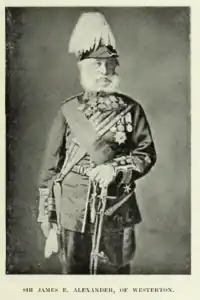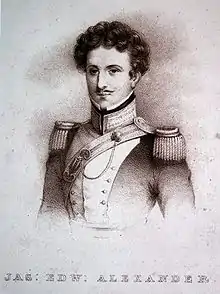General Sir James Edward Alexander Kt KStJ CB KLS FRSE FRGS[11] (16 October 1803 – 2 April 1885) was a Scottish traveller, author and soldier in the British Army.
Alexander was the driving force behind the placement of Cleopatra's Needle on the Thames Embankment.[11]
Background
Born in Stirling,[11] he was the eldest son of Edward Alexander of Powis, Clackmannanshire, and his second wife Catherine Glas, daughter of John Glas, Provost of Stirling.[7]
The family purchased Powis House near Stirling in 1808 from James Mayne (his uncle by marriage) for £26,500. His father, a banker, had to sell Powis House in 1827 on collapse of the Stirling Banking Company.[12] He received his training in Edinburgh, Glasgow, and the Royal Military College, Sandhurst.
In 1837, he married Eveline Marie Mitchell (16 April 1821 – 1906), daughter of Colonel Charles Collier Michell, RA, surveyor general of Cape of Good Hope, in Cape Town on 25 October 1837.[12]
In 1853, he obtained Westerton House in Bridge of Allan, built in 1803 by Dr John Henderson of the East India Company (a cousin and friend). Here he became an elder of Logie Kirk, walking there each Sunday.[12]
He died in Ryde on the Isle of Wight but is buried in Old Logie Churchyard just east of his home town of Stirling.[11] The graveyard lies several hundred metres north of Logie Cemetery and the 19th century Logie Kirk.
After his death, his trustees sold Westerton House to Edmund Pullar.
Military career
In 1820, he joined the British East India Company's army, transferring into the British Army in 1825. As aide-de-camp to the British envoy to Persia, he witnessed fighting during the war between Persia and Russia in 1826 and in 1829 was present in the Balkans during the Russo-Turkish War, 1828-1829.
From 1832 to 1834, he witnessed the War of the Two Brothers in Portugal, and in 1835 he took part in the 6th Cape Frontier War in South Africa as aide-de-camp and private secretary to Sir Benjamin d'Urban.
In 1838, he was made a Knight Bachelor for his services.[7] From 1841, he served in Canada, among others in the staff of Sir William Rowan. During the Crimean War, he commanded the 14th (Buckinghamshire) Regiment of Foot as lieutenant-colonel in the Siege of Sevastopol in 1855[7] and held an important command during the New Zealand Wars, from 1860 to 1862.[13][14] He retired from active service in 1877 and on 1 July 1881 was given the honorary rank of general.[15]
Explorer
On behalf of the Royal Geographical Society (which he had co-founded), he conducted an exploring expedition into Namaqualand and Damaraland, lasting from 8 September 1836 to 21 September 1837,[16][17] in the course of which he collected rock specimens, pelts of rare animals, bird skins, weapons and implements from the Herero and Nama, as well as drawing maps of the region and making a first list of Herero words.[18][19]
Subsequently, John Arrowsmith (cartographer) made use of his data to draw a map accompanying his book of the expedition. Alexander Bay on the Orange River mouth, is named after him.[17]
In 1877, he was largely responsible for the preservation and transfer of Cleopatra's Needle to England.[16][11]
 General Sir James Edward Alexander c.1880
General Sir James Edward Alexander c.1880 The grave of General Sir James Edward Alexander, Old Logie Kirkyard
The grave of General Sir James Edward Alexander, Old Logie Kirkyard
Works
- Alexander, James Edward (1827). Travels from India to England: Comprehending a Visit to the Burman Empire, and a Journey Through Persia, Asia Minor, European Turkey, &c. In the years 1825–26. London: Parbury, Allen, & Co.
- Alexander, James Edward (1830). Travels to the Seat of War in the East, through Russia and the Crimea, in 1829. With Sketches of the Imperial Fleet and Army, Personal Adventures, and Characteristic Anecdotes. Vol. 1. London: Henry Colburn and Richard Bentley.
- Alexander, James Edward (1830). Travels to the Seat of War in the East, through Russia and the Crimea, in 1829. With Sketches of the Imperial Fleet and Army, Personal Adventures, and Characteristic Anecdotes. Vol. 2. London: Henry Colburn and Richard Bentley.
- Alexander, James Edward (1833). Transatlantic Sketches: Comprising Visits to the Most Interesting Scenes in North & South America & West Indies with Notes on Negro Slavery and Canadian Emigration. Vol. 1. London: Richard Bentley. ISBN 9780608434056.
- Alexander, James Edward (1833). Transatlantic Sketches: Comprising Visits to the Most Interesting Scenes in North & South America & West Indies with Notes on Negro Slavery and Canadian Emigration. Vol. 2. London: Richard Bentley.
- Alexander, James Edward (1835). Sketches in Portugal During the Civil War of 1834: With Observations on the Present State and Future Prospects of Portugal. London: James Cochrane and Co. – via National Library of Portugal.
- Alexander, James Edward (1837). Narrative of a Voyage of Observation among the Colonies of Western Africa, in the Flag-Ship Thalia; and of a Campaign in Kaffir-Land, on the Staff of the Commander-in-Chief, in 1835. Vol. 1. London: Henry Colburn.
- Alexander, James Edward (1837). Narrative of a Voyage of Observation among the Colonies of Western Africa, in the Flag-Ship Thalia; and of a Campaign in Kaffir-Land, on the Staff of the Commander-in-Chief, in 1835. Vol. 2. London: Henry Colburn.
- Alexander, James Edward (1838). An Expedition of Discovery into the Interior of Africa: Through the Hitherto Undescribed Countries of the Great Namaquas, Boschmans, and Hill Damaras, Performed Under the Auspices of Her Majesty's Government and the Royal Geographic Society. Vol. 1. London: Henry Colburn – via BHL.
- Alexander, James Edward (1838). An Expedition of Discovery into the Interior of Africa: Through the Hitherto Undescribed Countries of the Great Namaquas, Boschmans, and Hill Damaras, Performed Under the Auspices of Her Majesty's Government and the Royal Geographic Society. Vol. 2. London: Henry Colburn.
- Alexander, James Edward (1839). Life of Field Marshal, His Grace the Duke of Wellington: Embracing His Civil, Military, and Political Career to the Present Time. Vol. 1. London: Henry Colbourn.
- Alexander, James Edward (1840). Life of Field Marshal, His Grace the Duke of Wellington: Embracing His Civil, Military, and Political Career to the Present Time. Vol. 2. London: Henry Colbourn.
- Alexander, James Edward (1849). L'Acadie: or Seven Years' Explorations in British America. Vol. 1. London: Henry Colburn.
- Alexander, James Edward (1849). L'Acadie: or Seven Years' Explorations in British America. Vol. 2. London: Henry Colburn.
- Alexander, James Edward (1857). Passages in the Life of a Soldier, or, Military Service in the East and West. Vol. 1. London: Hurst & Blackett.
- Alexander, James Edward (1857). Passages in the Life of a Soldier, or, Military Service in the East and West. Vol. 2. London: Hurst & Blackett.
- Adamson, William Agar (1860). Alexander, James Edward (ed.). Salmon-Fishing in Canada. London: Longman, Green, Longman, and Roberts. doi:10.5962/bhl.title.56138 – via BHL.
- Alexander, James Edward (1863). Incidents of the last Maori-War in New Zealand, with Illustrations of Native Character, and the Prospects of Intending Colonists. London: Richard Bentley.
- Alexander, James Edward, ed. (1863). The Albatross: Record of Voyage of the "Great Britain" Steam Ship from Victoria to England in 1862. Stirling: Charles Rogers & Co. – via Trove.
- Alexander, James Edward (1865). Notes on the Maories of New Zealand: with Suggestions for their Pacification and Preservation. London: Aborigines' Protection Society.
- Alexander, James Edward (1873). Bush Fighting: Illustrated by Remarkable Actions and Incidents of the Maori War in New Zealand. London: Sampson Low, Marston, Low and Searle. nla.obj-12875072.
- Alexander, James Edward (1879). Cleopatra's Needle, the Obelisk of Alexandria: Its Acquisition and Removal to England. London: Chatto & Windus.
References
- 1 2 3 4 WO 25/784/143, Folio 293: Statement of the Services of Capt. James Edw. Alexander of the 42nd Regiment of Foot with a Record of such other Particulars as may be useful in case of his Death, The National Archives, Kew, 1829, pp. 293–294
- ↑ "War-Office, March 9, 1832". The Edinburgh Gazette. No. 4050. 16 March 1832. p. 71.
- ↑ "War-Office, 11 September 1840". The London Gazette. No. 19892. 11 September 1840. p. 2044.
- ↑ Hart, Henry George (1854). The New Annual Army List, and Militia List, for 1854. Vol. 15. London: John Murray. p. 165.
- 1 2 3 4 Hart, Henry George (1877). The New Annual Army List, Militia List and Indian Civil Service List, for 1877 (PDF). Vol. 38. London: John Murray. p. 16.
- ↑ "St. James Palace". The London Gazette. No. 19833. 6 March 1840. p. 555.
- 1 2 3 4 Dod, Robert P. (1863). The Peerage, Baronetage and Knightage of Great Britain and Ireland for 1863. London: Whitaker and Co. p. 87.
- 1 2 3 4 5 6 7 8 9 10 Bonhams (2014). "Auction: Medals, Bonds, Banknotes and Coins, 12 November 2014, Knightsbridge, London. LOT 66: A C.B. and K.St.J. group of eleven to Major General Sir James Edward Alexander, 14th Foot, late 16th Lancers and 13th Light Dragoons". Bonhams. Retrieved 31 October 2023.
- ↑ "War Office, May 24, 1873". The London Gazette. No. 232979. 24 May 1873. p. 2583.
- ↑ "Whitehall, March 26, 1834". The London Gazette. No. 19143. 4 April 1834. p. 616.
- 1 2 3 4 5 Waterston, Charles D; Macmillan Shearer, A (July 2006). Former Fellows of the Royal Society of Edinburgh 1783-2002: Biographical Index (PDF). Vol. 1. Edinburgh: The Royal Society of Edinburgh. ISBN 978-0-902198-84-5. Retrieved 8 December 2011.
- 1 2 3 Fergusson, Robert Menzies (1905). Logie: A Parish History;. Paisley: Alexander Gardner.
- ↑ "Matters Military: 14th, or Buckingham Regiment". The New Zealand Herald. Vol. 2, no. 404. 28 February 1865. p. 6.
- ↑ "Colonel Sir James E. Alexander, in Answer to "L," of the Southern Cross". The Daily Southern Cross. Vol. 20, no. 2192. 30 July 1864. p. 7.
- ↑ "Memoranda". The London Gazette. No. 25085. 17 March 1882. p. 1215.
- 1 2 "General Sir James Edward Alexander, Kt., C.B., K.C.L.S., &c" (PDF). Proceedings of the Royal Society of Edinburgh. 14: 170–174. 1888. doi:10.1017/S0370164600004843.
- 1 2 Gunn, Mary; Germishuizen, G. (2010). Botanical Exploration of Southern Africa. An Illustrated History of Early Botanical Literature on the Cape Flora: Biographical Accounts of the Leading Plant Collectors and Their Activities in Southern Africa from the Days of the East India Company Until Modern Times. Strelitzia 26 (2 ed.). Pretoria: South African National Biodiversity Institute. pp. 75–76. ISBN 9781919976549 – via BHL.
- ↑ Alexander, James Edward (1838). An Expedition of Discovery into the Interior of Africa: Through the Hitherto Undescribed Countries of the Great Namaquas, Boschmans, and Hill Damaras, Performed Under the Auspices of Her Majesty's Government and the Royal Geographic Society. Vol. 1. London: Henry Colburn – via BHL.
- ↑ Alexander, James Edward (1838). An Expedition of Discovery into the Interior of Africa: Through the Hitherto Undescribed Countries of the Great Namaquas, Boschmans, and Hill Damaras, Performed Under the Auspices of Her Majesty's Government and the Royal Geographic Society. Vol. 2. London: Henry Colburn.
- ↑ International Plant Names Index. J.E.Alexander.
- This article incorporates text from a publication now in the public domain: Chisholm, Hugh, ed. (1911). "Alexander, Sir James Edward". Encyclopædia Britannica. Vol. 1 (11th ed.). Cambridge University Press.
